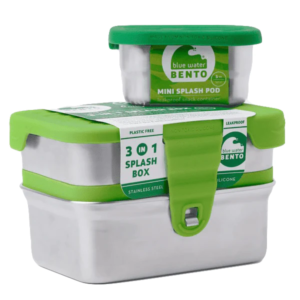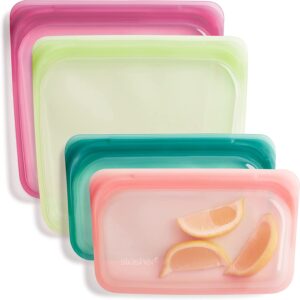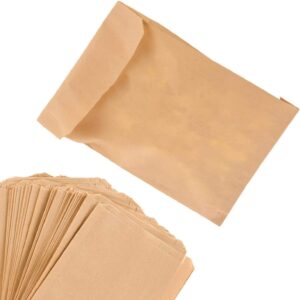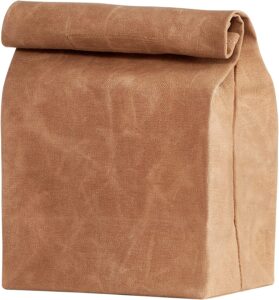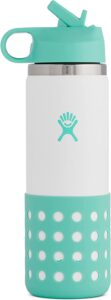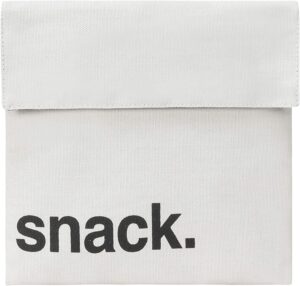
When it comes to your child’s health, every choice matters — even the container their lunch comes in. That adorable kids lunch box might look fun and functional, but what is it actually made of? Most conventional lunch gear is filled with plastic components that leach hormone-disrupting chemicals into food — especially when exposed to heat, moisture, or acidic snacks.
I believe that creating a safer, toxin-free home starts with small, impactful swaps. The lunch box is a great place to begin — it’s something you use every single day, and a few smart changes can make a big difference for your child’s long-term wellness. Let’s break down the why behind going plastic-free, and the how to upgrade your kids lunch box to a healthier, toxin-free version that’s still totally practical.
Why Your Kids Lunch Box Might Be Hiding Toxins
Even if it’s labeled “BPA-free,” most plastic lunch containers still contain hormone-disrupting chemicals. These hidden toxins — like phthalates, bisphenols, and PVC — don’t stay trapped in the plastic. They migrate into food, especially when containers are microwaved, washed in hot water, or used with acidic or oily foods (think: tomato sauce, peanut butter, citrus).
And while adult exposure matters, kids are more vulnerable. Their systems are still developing, and even low-level chemical exposure can impact their hormone balance, brain development, and immune system.
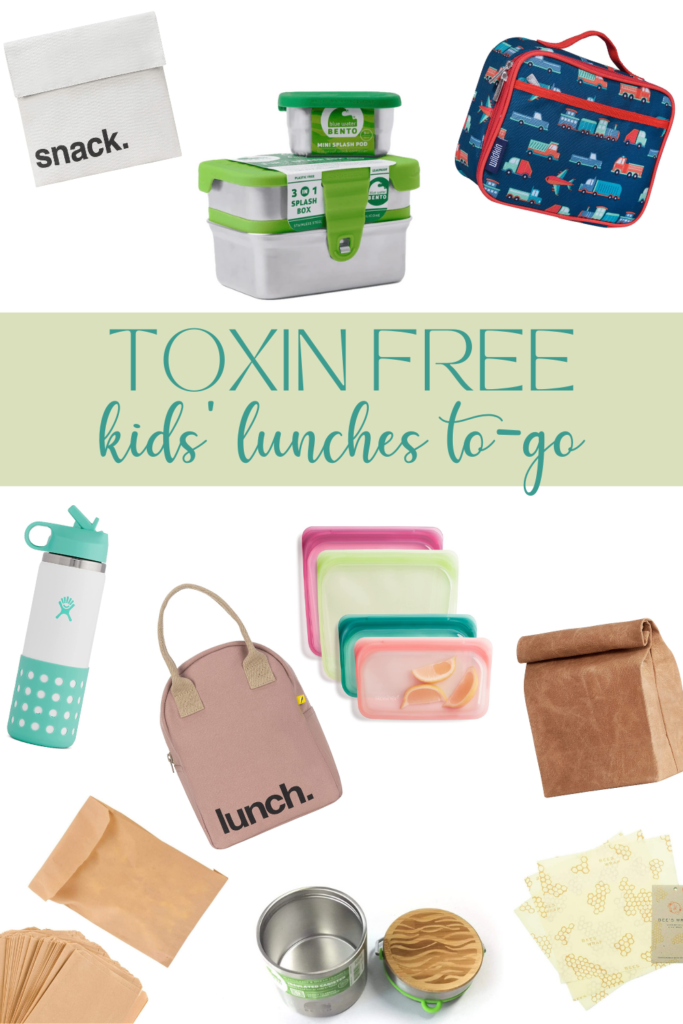
Common Plastic Toxins in Lunch Containers
I’m going to just say it — there is no plastic that is truly 100% safe or healthy for kids lunch box options. Even if the product boasts BPA free or PVC free, there are still other toxins present that are just not as regulated, but still dangerous.
This is why the best approach is to just completely remove plastic from your kids lunch box inventory to be completely nontoxic. Some of the big toxins in plastics are especially harmful with regular use:
Bisphenol Toxins: Bisphenol toxins like BPA, BPS and BPF (and there are others) have started to become regulated. However, just a word of warning, something that is “BPA free” probably also has other bisphenol toxins like BPS (which is actually more dangerous).
Bisphenol toxins mimic estrogen and disrupt our natural hormone production. And in the US, studies have shown that nearly ALL of us have BPA toxins in our bodies Which really means that we’re all being exposed to this toxin in such large amounts that our bodies are unable to keep up with naturally getting rid of it before more enters our bodies.
Bisphenol toxins have been linked to obesity (especially in children), impaired learning and memory, aggressive behaviors, increased risk of type 2 diabetes and impaired glucose tolerance, altered liver function, impaired reproductive function and early onset puberty. (STUDY)

Polyvinyl Chloride: Polyvinyl Chloride, or PVC is made up of a slew of toxic chemicals that are harmful to humans and especially our kids. PVC plastic releases toxins such as dioxins and phthalates during its life lifecycle, which we come in contact with during the use of these plastics.
The human body has been negatively affected by these toxins and over time the chemicals have been shown to cause cancer, harm the immune system and negatively affect the reproductive system. (PVC Toxins)
Phthalates: Phthalates are a type of toxin within plastic that is HIGHLY unregulated. This means that the toxin can be in ANY plastic you or your kids come in contact with, and legally, no one needs to let you know about it.
Phthalates build up in the body as we are exposed to them and because of this, the body has a hard time detoxifying it fast enough. In fact, an EPA study showed that most children’s bodies contain WELL over the allotted limit. (STUDY)
Phthalate exposure has been linked to abnormal reproductive development as well as neurological toxicity in kids and adults. (STUDY)
Some phthalates are also known endocrine disruptors, meaning they hinder our natural hormone production and can in turn cause issues with thyroids, immune system and the reproductive process (STUDY)
An in-depth study also states, “Recent studies also show that prenatal exposure to phthalates is associated with adverse impacts on neurodevelopment, including lower IQ, and problems with attention and hyperactivity, and poorer social communication. ” (SOURCE)

Styrene: The good news about Styrene is that it has been tested and studied showing it is not an endocrine disruptor. However, there are other problems that this toxin exposure poses for those who come into contact with it even at low exposure rates.
The big red flag is that because Styrene is classified as a mutagen, it also means it’s potentially carcinogenic to humans. In fact, Styrene has been anticipated to be a probable carcinogen to humans, as it has already been shown as carcinogenic to animals.
Styrene also has many harmful side effects on the central nervous system, causing significant negative changes to the nervous system itself. It has also been shown to cause memory loss, difficulties in concentration and learning, brain and liver damage. In line with these cognitive issues, Styrene has been linked to poorer visual and sensory function in those with moderate exposure to the chemical.
In pregnant women, Styrene exposure at moderate levels has been linked to low birth weight as well as reduced fertility in otherwise healthy women.
And finally, Styrene is a contributor to chronic diseases and accelerates the onset and progression of these diseases in otherwise healthy individuals.

Best Toxin-Free Kids Lunch Box Materials
Stainless Steel: Stainless steel is an excellent option when it comes to kids lunch box options. I love that they are basically indestructible and aren’t going to be super heavy for them to carry around either. A high grade stainless steel such as surgical grade or 188 or 18/10 is best as it won’t have any aluminum, chromium or nickel present in the material.
Food Grade Silicone: Reusable snack bags, gallon bags and sandwich bags are perfect to have on hand for snacks or separating food in a kids lunch box. Silicone should be food grade or platinum to ensure that it is pure silicone and safe for contact with food.
***Food Grade silicone is only safe if there are no cuts in the material and as long as it does not store warm or hot food.
Glass: The OG of nontoxic materials. Glass containers are often very durable and despite what you might think, don’t break all that often. You can find glass containers with silicone sleeves to protect them even more in your littles hands. It’s also usually a pretty inexpensive swap when you’re switching from plastic to nontoxic materials. And as a side note, we love glass because it can usually go right into the oven for a quick reheat.
Paper: Paper products like sandwich paper, butcher paper and parchment paper are GREAT additions to your inventory for lunchtime. They’re all toxin free and can be really handy to quickly wrap up something that might not need an entire container. Plus, if your kids are anything like one of mine, you might hesitate sending containers to school for fear you may never see them again. Paper is great in this sense as it can be recycled instead of brought back home.
Make sure that the paper products you use are not lined or bleached to make sure there are no added chemicals or toxins to the product.
Healthy House Approved Lunch Box Components
How to Transition to a Toxin-Free Lunch Setup
Building a healthy home doesn’t mean throwing everything out overnight. A slow, mindful transition is better — both for your wallet and the planet.
Here’s a step-by-step plan you can use (or recommend to a friend!):
- Declutter the Old: Toss broken or worn-out plastic pieces — especially stained or scratched ones.
- Swap the Most-Used First: Focus on daily-use items like sandwich containers or snack bags.
- Build in Layers: Add reusable bags, bento boxes, and insulated jars over time.
- Label Everything: Kids misplace things! Use name labels to keep your new containers out of the lost-and-found.
Avoid Heating Plastic: Even in a pinch — don’t microwave or pour hot foods into plastic containers.
Smart Swaps = Long-Term Gains
As a building biology practitioner and mom myself, I’ve seen firsthand how small swaps can reduce toxic exposure and improve wellness over time. A kids lunch box might seem like a minor detail — but it’s used hundreds of times a year. That adds up.
By switching to non-toxic materials, you’re protecting your child’s health at a cellular level — and creating a ripple effect that impacts their hormones, behavior, and immune system.

Making a healthy home starts with simple habits — and a toxin-free lunch is a habit that sticks. When you prioritize safe materials and smarter choices, you’re teaching your kids that their health matters and empowering them to do the same.
Share this:
- Click to share on Facebook (Opens in new window) Facebook
- Click to share on LinkedIn (Opens in new window) LinkedIn
- Click to share on Reddit (Opens in new window) Reddit
- Click to share on Pinterest (Opens in new window) Pinterest
- Click to print (Opens in new window) Print
- Click to share on X (Opens in new window) X


